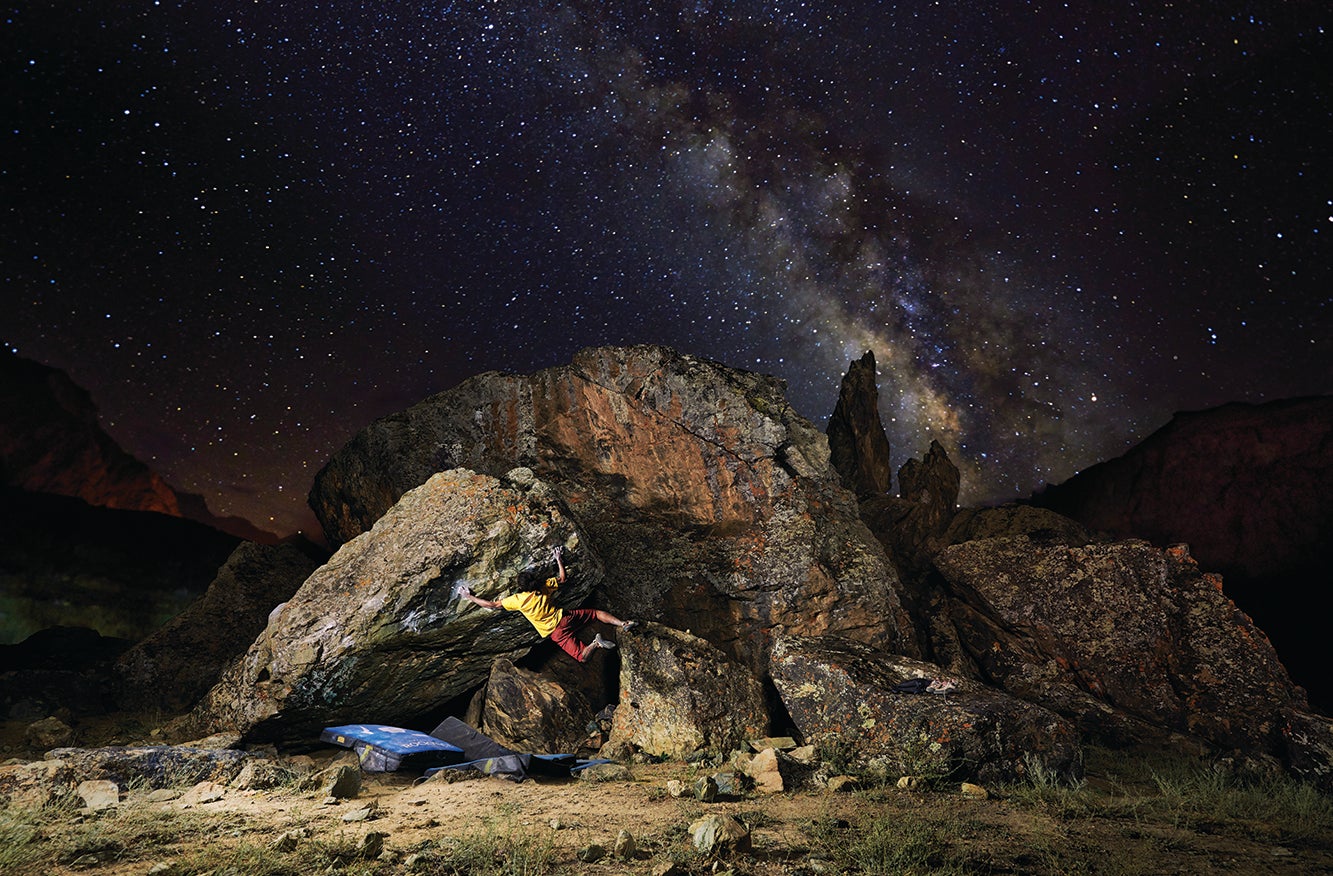Bouldering Under the Roof of the World

Sandeep Maity busts a move on Green Mamba (V9), Quantum Sector, with the Milky Way as a witness. Maity is an Indian national climbing champion and works as a freelance climbing instructor. A climber of 10 years, he has opened more than 500 boulders across India. Photo by Sharad Chandra
The boulders of Suru lie in the barren land of Ladakh, in the broad Himalayan foothills of northern India. Suru and its seemingly infinite boulders lie spattered at the base of a valley by the same name. A 40-kilometer journey from the mountain village of Kargil will get you to the blocks, whose existence was only discovered in 2011.
While snow-capped mountains likely come to mind when you think of the Himalaya, the Suru Valley may have you rethinking. It’s huge boulders have recently captured the attention of Indian climbers. Here, prime boulders sit among the trees while others are surrounded by lush meadows, while still others perch delicately on scree. Pick any compass point, walk and you will dead end at a block. It’s boulder after boulder under blue skies and steep slopes. Remarkably, having no one peculiarity is the peculiarity of Suru boulders: steep roofs, techy vert, highballs.
Clustered on both sides of the Suru River, the boulders are at an average altitude of 9,500 feet. In season, the climate is neither too cold nor too hot, and the green schist metamorphic rock is finger-friendly. The ideal season is July to September, as the snow only begins to melt around May. Elsewhere in India this is the monsoon season, but because the Ladakh Himalaya are in a rain shadow, the area remains dry.
Tenzing “Jammy” Jamyang, 39, and Suhail Kakpori, 37, two veteran climbers from Ladakh, found the boulders through a friend.
“I believe Suru was destined to be a climbing spot,” Jamyang says. “A multitude of boulders lay walking distance apart. Every climber dreams of such a setting.”
Development of Suru was slow at first, then a breakthrough came after five years, in 2016, courtesy of the Suru Bouldering Festival. “One day in 2015, my friends and I decided to do something,” says Jamyang. “We picked an array of days for the festival and posted on Facebook. I solicited all the Indian climbers and my foreign friends to visit the site. I offered to sponsor their travel.”
Getting visitors to Leh and then Suru was a convoluted proposition. Yes, Leh has flights from Delhi and Srinagar, but most climbers drive to Leh from Manali, about 28 hours via a stunning mountainous road. Still, they came.
“We had faith. We simply wanted people to establish as many problems as possible,” says Kakpori, “We conducted the first rendition of Suru fest with 50 climbers from all over the world. Our crew played a major role in achieving this dream. As they say, a team with a similar drive can make anything become a reality.”
The Suru valley made headlines when Pirmin Bertle, a Swiss climber, gave India its hardest problem, Bacteria (8B+/ V14) in the upper Suru Valley at Rangdum, at an elevation of 12,000 feet, and with nails-hard crimping to a dicy exit.
“Suru Valley is huge. I think we have just explored one to two percent of climbing. Our current campsite is at a lower altitude. Rangdum at 4,000 meters has no road access and climbers need acclimatization,” says Jamyang. “In the coming years, we are expecting the fest to burgeon to the upper valley,” he says. Apart from bouldering, there is huge untapped potential for big-wall trad climbing.
Both 2017 and 2018 saw unprecedented growth for the festival, as Kashmir and Ladakh Tourism, as well as other entities, poured in sponsorships. The Suru festival won the 2019 UIAA Rock Climbing Festival Award, and was later renamed the Suru Outdoor Festival, to welcome not just climbers but also highliners, kayakers, BASE jumpers, yoga lovers, and artists.
On the way to becoming a world-class climbing hotspot, Suru has provided a new source of employment to local villagers, who oblivious to bouldering, were amused and initially hesitant to allow people on their fields.
“Rocks are merely rocks for us. We either use them for construction or crush them for roads,” says Muzammil Hussain, a native from Kargil. “Now we realize the grandeur of wealth in our backyard. None of us could have imagined our least-developed and remote homeland will be marked as an International Climbing Destination on the world map—forever!”
Nutan Shinde-Pawar of India writes for UKClimbing, UKHillWalking, Gearjunkie, ExplorersWeb, Trek the Himalayas and others, and manages social media for MojaGear and The Climbing Initiative.
Opened by Sandeep Maity in 2016, Shroom (V6) is a classic: powerful, short and close to the campsite in the Quantum sector. As the name suggests, the boulders in this area require intricate movement and fine-tuned technique, as shown here by Prerna Dangi, a professional mountain guide and one of the few all-arounders in India, also proficient on ice and in the high mountains. She promotes ice climbing in India through the Piti-Dharr Ice Climbing Festival, and is a co-founder of CLAW (Climb Like a Woman), an initiative to grow the women’s climbing community.
Varun Mishra loosens up on Beautiful Mind (V9), in the Beyul area. This stunning problem takes on a 45-degree overhanging arete. It doesn’t get much better. Mishra is the chief route setter at the Boulder Box in Delhi. He has been climbing since 2014, and after only five years won a bronze medal in India’s 2019 Open Nationals.
The Beyul sector is the largest in Suru with around 70 problems, and many more ripe for development. From easy warm-ups to V13 projects, Beyul caters to all levels.